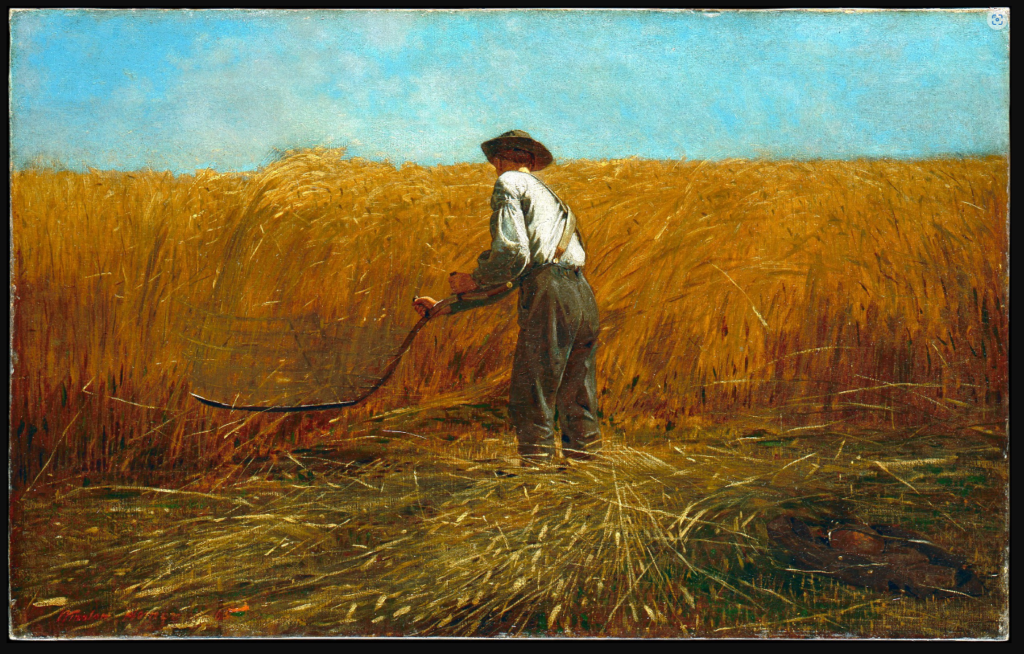20 October 2022
Winslow Homer: Force of Nature
The National Gallery (until 08/01/23).
By William Morton

Ignoring the pull of the Cézanne Exhibition at Tate Modern and turning our back on the boulevards and boating at Argenteuil, it’s time for some New World realism as exemplified by the works of Winslow Homer (1836 – 1910).
He was an interesting man. Born into an established Boston family, he trained as a lithographer and then made a living selling illustrations to magazines and newspapers before becoming a painter full-time. He did travel, visiting France and England. In his later years, he lived a somewhat hermit-like existence in Maine but usually spent the winter in warmer locations such as Florida, Cuba and the Bahamas. He did paint women but in everyday situations and seemed not to feel any particular need for their company or indeed any company but was on good terms with his brothers throughout his life.
He did not like to explain his work, saying ‘I regret very much that I have painted a picture that requires any description. I will paint for money any time.’ However, looking at his pictures, one has to conclude this was not really true and that usually he had a message he wanted to convey.
A key period in his life was the American Civil War (1861 – 1865), which is said to have understandably affected him deeply. Homer was sent to the front by Harper’s Weekly Illustrated Magazine to provide it with illustrations of the conflict. He used his experiences to paint some strong pictures such as Sharpshooter, a Unionist sniper sitting in a tree and using a telescopic sight, and Prisoners from the Front in which a swaggering Confederate and his ragged companions surrender to a smartly dressed Unionist office.
In the aftermath of the war, he painted The Veteran in a New Field in which the veteran with his scythe is almost dominated by the corn he is cutting, implying that the future will be hard. He was also clearly aware that the lives of former slaves were not greatly changed by emancipation and that many remained in the service of their old owners on little improved terms. The Cotton Pickers shows two black girls at work alone in a large field of cotton. There is the distinctly uneasy atmosphere of A Visit from the Old Mistress in which female former slaves stare at their smartly dressed former owner not knowing how to react. Homer remained conscious of black exclusion. A much later painting, A Garden in Nassau, shows a small black child gazing at the gleaming white outer wall of the garden. There is a clear sense that behind the wall is something of which he knows nothing and from which he is excluded.
In later years, the main focus of Homer’s work was the sea. There is a suggestion that this is because he knew that seascapes sold but there is nothing soft about them. In the well-known The Gulf Stream, a black fisherman is adrift on his de-masted boat surrounded by sharks with some sugar cane beside him. There is a ship in the background but no indication that it will rescue him. It is thought that the picture symbolises the sugar and slave trades, whose ships’ passage was assisted by the Gulf Stream, and how the blacks used in them were cast aside.
He spent two years at Cullercoats, a Northumberland fishing village, where he painted sympathetically, usually using watercolours, the hard lives of the fishermen and their families against the background of the sea. There is a rescue using a lifeline and wives watching out for the return of their husbands’ boats. In The Life Brigade, the crew is shown looking out at a stormy sea and their anxiety is clear even though their faces are not shown.
One can see why Homer is considered one of the greatest US painters and this is an interesting and enjoyable exhibition. It was sparsely attended when I went, which is a pity. This may be due to the fact that Homer is not particularly well-known in the UK – and he is competing with Lucien Freud who also has a major exhibition in the National Gallery at the moment.


